
Worksheet to evaluate the components of a political cartoon.
- Provider:
- Cartoons for the Classroom
- Date Added:
- 06/24/2019

Worksheet to evaluate the components of a political cartoon.
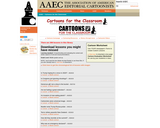
This webpage has approximately 300 political cartoons and lessons for classroom use covering an variety of current events. Each cartoon has talking points, a blank cartoon students can caption and additional resources. Note* This lesson works well with the following cartoon evaluation resource (Cartoon Evaluation Worksheet): http://nieonline.com/cftc/pdfs/eval.pdf

In this lesson, students will confirm, negate, and build information about the nation’s changing demographic using an organizational chart; write a letter to respond to a viewpoint offered in the central text; and talk about their own multiple identities in relation to those around them.

This resource is a nonfiction, Common Core aligned reading passage with textual analysis questions about main idea, characterization, and supporting details.

Students read and analyze a topical news article about some aspect of climate change and share their analysis with their classmates.
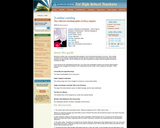
This Random House for High School Teachers reader's guide includes discussion questions for The Collected Autobiographies of Maya Angelou to aid in student comprehension and understanding of the famous author and her life.

Students share opinions about the tone and content of two commercials presented during the Super Bowl.They then work with a partner to critique a commercial from a past Super Bowl, and then assess the commercials that run during a half-hour television show.

Students read two descriptions of Earth's interior structure and summarize similarities and differences between the two and answer a series on analysis questions.

This media gallery explores the inspiration for and reception of The Crucible during the Hollywood Blacklist with videos from the PBS American Masters film, None Without Sin. The videos and support materials are best used during or after a reading of The Crucible. Using video, text, graphic organizers and text-dependent discussion questions, students will better understand the symbolism of The Crucible and why Arthur Miller was compelled to write the play.
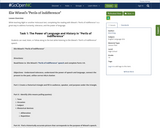
While teaching Night or another Holocaust text, completing the reading with Wiesel's "Perils of Indifference" is a great way to address humanity, tolerance, and the power of language.

In this lesson, student evaluate arguments using both objective criteria and their own perspective of the issue, learning how to use research in order to develop and support their own position.

In this lesson, students will complete their reading of "How your Addiction to Fast Fashion Kills" and use the Evaluating Argument and Evidence Tool to explore the author's arguments.

In this lesson on Family Ties from Teaching Tolerance, students will critically evaluate media messages on the issue of immigration and families, illustrate a narrative, and prepare and conduct an interview and debate on how undocumented status affects the day-to-day lives of immigrant families, particularly women.

In 1845, the Narrative of the Life of Frederick Douglass, an American Slave, and Written by Himself was published. In it, Douglass criticizes directly often with withering irony those who defend slavery and those who prefer a romanticized version of it.

This activity engages students in an analysis of the 2008 speech by Barack Obama on race. Students will then create an annotated version of the speech that has them analyze and comment upon Obama's use of history, rhetoric, and language in his message. Students can also create a hypertext of this assignment in order to publish works in different media.

Students will go "inside" the NY Times Best Sellers List to explore recent best sellers across categories, then use those lists as models to create their own in categories of their choosing. They will write one-sentence summaries for each book on their lists, then analyze and explain their choices by writing "Inside the List" articles. Ultimately, students will answer the question, "What do best-seller lists tell us about our culture?"
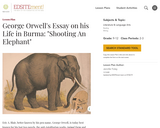
George Orwell's experiences as a policemen for the British Empire in India formed the basis for his early writings, including this essay. After receiving some background information on British rule in Burma as well as on Orwell, students will read the essay in order to analyze its use of metaphors, symbolism and irony.

In this multi-day unit students conduct research, work with an interactive Venn diagram tool, and create a museum exhibit that highlights the work of selected artists, musicians, and poets. Critical thinking, creativity, and interdisciplinary connections are emphasized.

This Random House for High School Teachers teacher's guide includes an introduction, discussion questions, suggestions for further reading, and author biography intended to enliven student discussion of Dave Eggers' autobiography about his life after the death of both his parents, A Heartbreaking Work of Staggering Genius, a thoughtful, moving, and at times uproariously funny memoir.
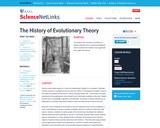
In this lesson, students examine how evolution has been scientifically explained historically. In doing so, students will read and analyze the arguments and theories set forth by three historically significant scientists: Jean Baptiste Lamarck, Alfred Russell Wallace, and Charles Darwin.